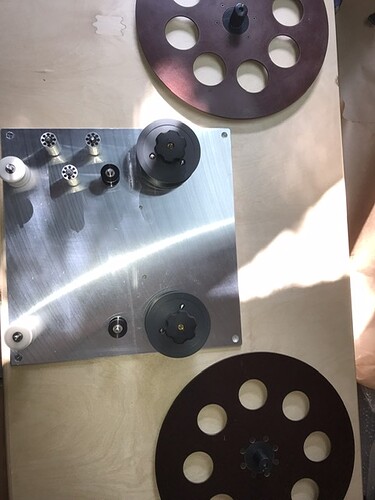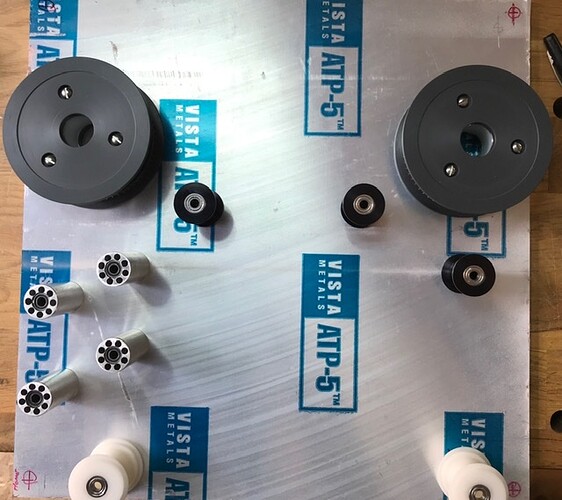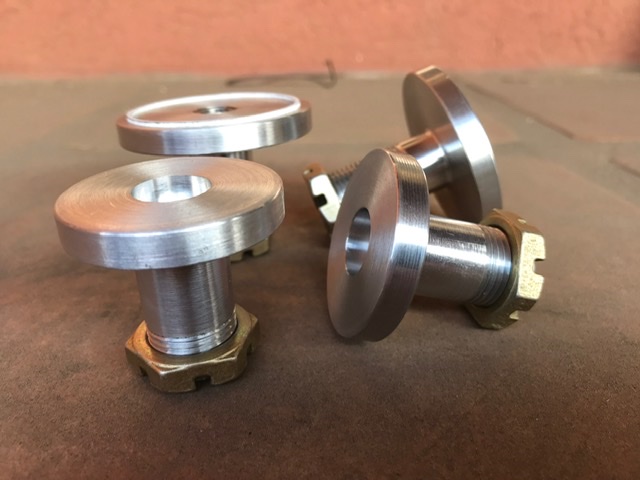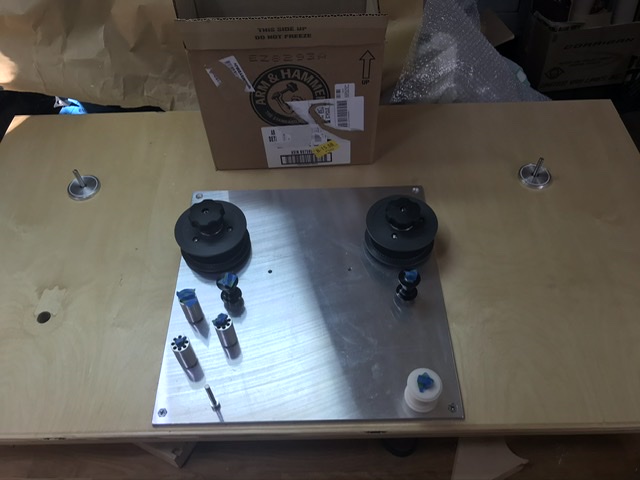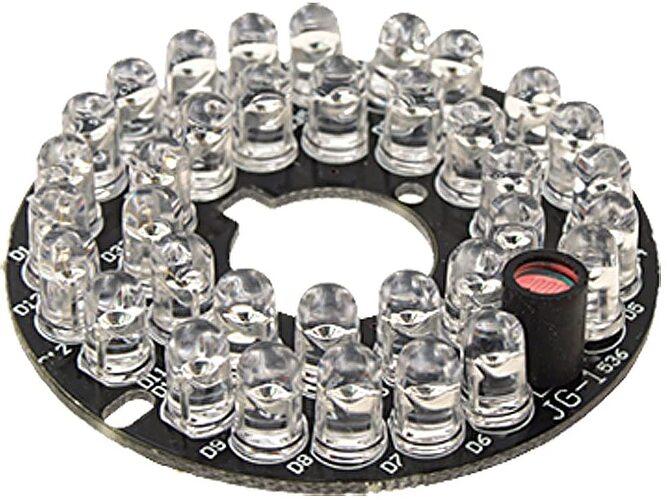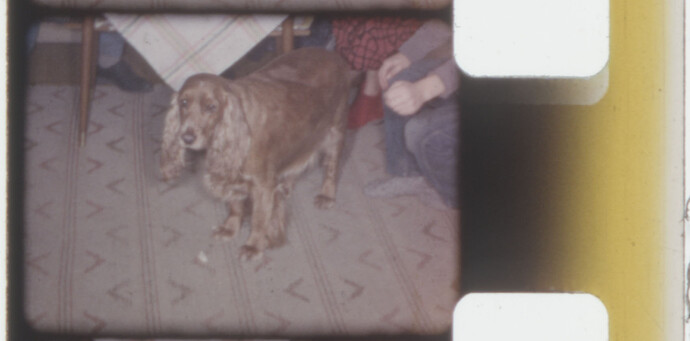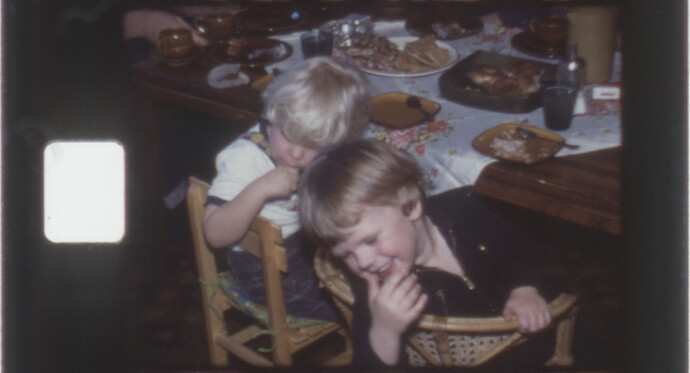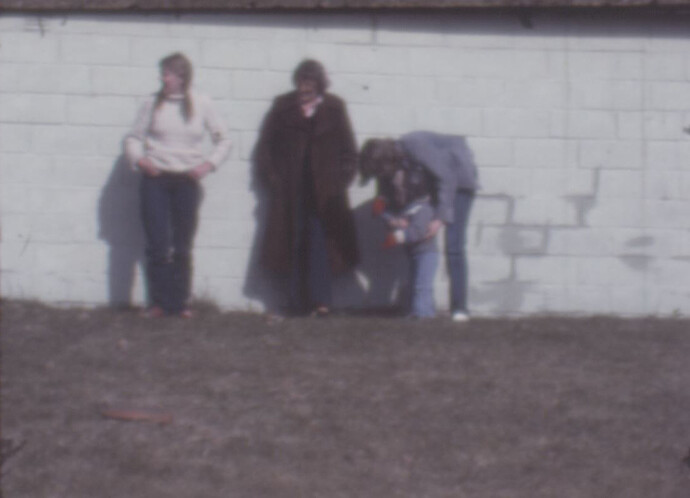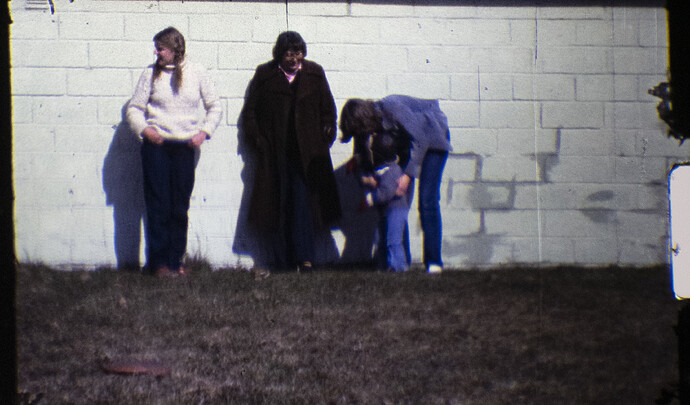Incredible work @Gregory_Dargent. Thanks for sharing!
Hello, I am a retired filmmaker (DGA UPM/1AD) based in Los Angeles. I have a goal of building a 35mm scanner for a feature I produced and have only standard def video transfer. I have been lurking here for a number of years once I found the forum and realized a 4K transfer was possible. So I started to build the transport mechanism and my computer engineer son offered to do the electrical/UI portion.
I am pretty handy mechanically and know my way around machine tools. After looking at Matthew’s first pass, and knowing how the machines are designed professionally I drew up a layout and started finding components.
My first score was a guy on eBay seller:davliegogo who bought out the inventory of Deluxe Film Labs when they stopped chemical processing film. He had a ton of rollers, a couple platters, PTR rollers, shafts and micro bearings. (I just did a quick look at his current listings and didn’t see a lot of film related, may need to ask)
I then asked on my local Nextdoor.com if anyone in the neighborhood had a lathe I could use. Discovered a great new friend with a complete machine shop in his garage which he’s graciously allowed me free reign.
So I bought a bunch of aluminum and started making chips.
Here’s a few random images
These are some of the mounts I turned:
My current focus is light source, will post more on the lighting thread.
Camera choice is also coming up but I figured to get the transport working and use an existing Nikon to test.
Matthew thanks for your work fon this. I noted previously you were seeking 35mm film stock for test, is that still a need? If so may be able to help. Let me know.
So cool @brian ! Be sure to check out the research by @johnarthurkelly on lighting here.
Wish I had a friend with a basement shop! Sounds like a fun project. Looking forward to seeing it progress. Please keep the updates coming.
I think I’m good for 35mm stock to test with for now but if I need more, it’s good to know you have some. Thanks for thinking of it!
Hey @brian - that looks like an awesome start to the build! I’m definitely happy to chat lighting, my scanner build is for 8mm and eventually 16mm, but the research I did here is for a 35mmx35mm gate (for potential frameline look-around, alternate frame sizes, etc.). I’m in the industry in NYC - currently managing a service shop for a rental house.
Matthew, yes I did find John’s PDF, thank you both. You should join your Nextdoor group and put out a request… was simple as that for me (in fact I found two!). Suspecting though if you live in NYC might not be the same as an LA suburb. My favorite class in High School was machine shop (when we actually still taught students trades) so I was able, after just a bit of supervision to have the owner feel comfortable with my work. I will post a few more pictures of the process (and a few from the machine shop). Next up as I mentioned will be to build the sphere and add the LED’s. One variation on your design is my take up/feed tensioners. I opted to use a weighted arm with an optical rotary encoder to feed the arduino a signal. Will let you know how it works. Looking forward to seeing your project in the field.
Hi,
Old hand at 3d printing and machining, been working on a way to scan in higher quality from old super8 and 8mm film going back to the early 60’s some of it of historical significance, after we had an old family film “digitized” and had the film irretrievably damaged including but not limited to projector light burns and poor handling and the quality of the DVD we were given of so poor quality it was almost unwatchable, while I’m 100% sure other companies are better today we refuse to take the risk the film is keeped in dark and dry metal containers so in no fear of deterioration. I started working on a few different ways to scan by way of a HI quality flatbed but never really liked the slow and occasionally varied results even whit the expensive flatbed.
After several years of giving up on the project for the moment i found this project and others and I just was floored whit what people have been doing, knew i could do something like that myself and started working on it.
I’m interested in making a very ‘simple’ design that would be mostly 3d printed, small enough to keep out of the way, relatively easy to convert from 8mm to super 8mm, I got the basis of a design, and I’m interested in thought on a few ideas.
On is camera Quality for best result, I got a Z cam e1 stored away that I plan on using for prototype.
Second, I’m interested in using IR Masking by way of mirrors to take two separate photos of each frame, one using a white diffused lit and another using IR, have any one made this work before?
I also have a ‘novel’ idea for a film gate or at least the part that hold the film for exposure to the camera, I’m planning to hold the film in place between to glass plates that swing out of the way when moving, I did notice some significant quality increase when this was done on flatbed.
Welcome @MrCapri, some interesting ideas there. 
I imagine the glass improves the quality in flat bed scans as it increases flatness, but you may not need that if you can get sufficient depth of field on your camera for scanning? Flatbeds don’t have variable apertures / depth of field, not in any I’ve owned anyway.
I think infared has been explored by people on this forum for dust/scratch removal, it’s certainly a big opportunity as it can work great on flatbed photo scanners. It’s likely to require a custom built light source, and perhaps some sort of manual sequencing between normal LED and IR light for each frame.
Thanks, I didn’t consider the depth of field pretty new to photographing film, the last week I have made some changes to my design reducing complexity. I also had a chance to pick up a Panasonic G80 cheaply so while the picture quality go up it will remove the IR Part because of the IR filer and I’m not going to remove it since I would like to use the camera for other things and from what I heard removing IR filter from G80 have a 75% chance to causing major problems whit focus and the stability, but I have been thinking about picking up another cheap crap thing and making the test whit, probably doing a threw put IR light whit a flip in interrupter mirror using a servo for visible light.
I have been pretty focused on a compact design something you can put in a drawer/box for reducing dust and let it run, there is only so much in terms of quality of the ‘scan’ you can get as an armature but we can do a lot for quality of life and ‘simplicity’
I’m using two stepper motors to advance the film a dc motor whit a 99:1 gear reduction for the winding control whit the tension arm controlling speed of winding and E-stop in case of break.!
That’s a great looking design! Looking forward to seeing it in action. Welcome, @MrCapri. We’re glad to have you.
Hi all,
I am a 2D/3D animator making motion graphics in the world of advertising for social media and TV. In the last few years I have jumped in the world shooting 16mm film and I’m currently working on a short documentary. In addition to shooting film I also collect found footage and would love to have an at-home option for scanning to keep costs down. I stumbled across Kinograph and looks like an awesome project! I see there are a number of marketing tasks and I would be happy to help in any way I can!
Best,
Adam
Welcome, @adamdargan! Glad to have you. I’ll definitely be reaching out to you re: marketing stuff!
Thanks, glad to be here, this should give a better idea of thow whole device, 225mm wide and 380mm long, most parts resin 3d printed, fixed on a cnc smilled playwood base, eventualy it will be fully enclosed to help whit keeping the light undisturbed and constant.
I have made a few experiment whit my G80 camera while it’s IR filterd it can still “see” some IR and it seem like evern whit the filter in place i should still be able to make an IR mask, my idea is to use someting like this.
Mount the white light in the middel behind a difuser (something like a LED from a flashlight whit focus and zoom) and then switched them on and off taking two pictures for each frame.
Great design! Wish I had you around when I was building v1 
 thanks, i’m sorry i was not around before i have been trying to get a proper and good way to transfer 8mm fim for years probobly going back to 2014, did some work half decent scanning donw back in 2016 but it was not anywhere near what i wanted in terms of quality, and there was still a problem whit flatbed focus on the film.
thanks, i’m sorry i was not around before i have been trying to get a proper and good way to transfer 8mm fim for years probobly going back to 2014, did some work half decent scanning donw back in 2016 but it was not anywhere near what i wanted in terms of quality, and there was still a problem whit flatbed focus on the film.
I kinda just lay it aside as my worklife kinda took a turn for shit i did start everything up agine and realy started to dile in many issues whit scanning and got some serius improvments, right before getting whit by a stroke in may of 2018 and i realy did not recover physicly or mentaly from that untill early this year as i started a new job, when Corona saw me ferlowed i needed something to keep me from going nuts and here i am… i NEVER considerd this idea is viabul back i the day.
Here is two test quality what i was able to get out of flatbed scanner.
This is the first video i was able to fully scan way back in 2014 and best show the problkem whit serius focus issues.
This is a origonal scan i did in 2014 whit flatbed, same issue whit focus that realy got to me.
This is the same frame scanned today (note i did this by hand so the quality is not the best it can be) whit a Panasonic g8
I’m qurently prototyping alot of the component for my device using 3d resin printing.
so will hopefully have something actuly physical to show ever the weekend.
Hi All.
I have a background in VHS/DVD duplication and tape mastering from the days of U-Matic to late HDCAM SR. All this has become something of the past.
I have great delight to work (play) with films since I got given a 16mm Steenbeck.
I bought a Retroscan, a great machine for its price and a 4K camera would be a great addition.
Some topics on Kinograph are very interesting, this why I decided to finally register.
Glad to have you, Oscar!
Hi there everyone! It seems I have found my people! By that I mean people interested in the preservation of older film in a digital format. By day I’m a pilot, although thanks to COVID I’m about to be furloughed. I have spent a lot of time as a software developer and an engineer in previous jobs as well, so while I’m not really a specialist in anything, I have a good understanding of writing software for both the PC and the embedded Arduino stuff, as well as a basic understanding of circuit design.
Like several of the others here I have built my own telecine for preserving 8mm/Super 8’s from my grandfather and father. My rig currently uses my family’s old Doral Dual 8 projector, with a Canon 5D MkII full frame DSLR. One of my design goals was to be as non-destructive to the original projector as possible.
The projector has a knob in the front, for manually advancing frames. I was able to take the knob off and attach a collar to the axle and extend the axle out so I could attach a pulley to it. I drive that pulley with a Nema 23 stepper driven by an Arduino. The Arduino also has the ability to turn off an IoT power relay so that it can shut the rig down when the movie is done capturing.
Because the frame rate is so slow at ~0.5 fps, (and even if it wasn’t this slow, the original bulbs are HOT and burn out after ~25 hours), I’ve designed a bulb to be a replacement for the original 8V 50W projector bulb using a Bridgelux LED. Right now I’m working on designing a bulb to be a drop in replacement for the original bulb - one that uses the projectors on-board power to drive the LED.
On the camera end of things - I currently project directly onto the CCD of the camera. To keep dust off the sensor I got a reverse mount attachment and put a UV filter on - there is no lens in the camera. Funny side effect of this is my frames capture upside down, which is easy to fix in post. I’m capturing the .CR2s directly and downloading to my PC over USB after each shot which is why it takes so long between each frame. I could speed this up if I lowered the resolution and saved directly to the CF card in the camera, but I want as much data as possible.
I’m using the Canon SDK to control the camera from my PC. This allows me to adjust every setting on the camera without touching it. If I choose to do HDRs in the future, it’s an easy addition. I’m using a ridonkulous resolution currently - 5616 x 3744. Believe it or not I get a lot of data from the old Super 8’s even at that resolution. I’m going to try a film this week at 3861 x 2574 and one at 2784 x 1856, to see the difference in quality/speed. I’d like to be able to have 4k scans ultimately, even though it there isn’t much point at this time - I’m planning for the future.
One of my driving philosophies as I’ve been doing this project is that I’m trying to capture as much data for the future as possible. Displays currently may not be better than 8bpp, but in the future they will likely have higher bit depths. Storing each frame as a .CR2 (Canon Camera Raw file) may take more hard drive space, but HDDs are getting cheaper all the time, and eventually SSDs will be cheap enough to store everything. Sure, I can’t tell the difference between HD and 4k on my HD monitor, but someday these may be projected from a 4k (or higher) projector the way these were meant to be seen! As post processing algorithms get better and better, I can run these through and get amazing output with no scratches, smoothed motion, no camera shake, etc. I shudder to think of all those people who captured their Super 8’s onto VHS at 480i and then tossed the film stock.
Finally - I don’t have the resources to save the original film forever. With digital I can make exact duplicates of the movie and store it redundantly. At some point I have to realize that despite my best efforts the original film will deteriorate. It will certainly not be playable on any projector at some point. I’d love to help people save their memories in an accessible way.
Here’s my first capture with my homebrew telecine: https://youtu.be/5MzvqOBTkW8 (I added the projector sound from a .wav file I downloaded from the internet)
I’m really enjoying reading the threads on lighting btw, so much knowledge here, and I hope to contribute to that.
Glad to have you here, @busting_bravo. Very glad to have someone with experience in software and Arduino aboard. We’d love to see some pics of your scanner! When you have the time, you can start a new thread in the forums with your documentation. We’d all learn a lot, I’m sure.
- what brought you to Kinograph?
You tube - I inherited a BUNCH of Super 8 from the 1970s of trains and I’d like to preserve and share. - what are you most excited about?
Tinkering and making something is better than paying a service as I see it. - what skills/knowledge can you offer others on the forum?
Not much I suppose. I have a bit of mechanics background and just dumb enough to try things.
